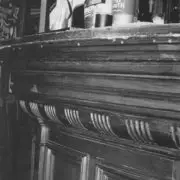RMS Olympic: Another Premature Death?
The ‘Olympic’ class suffered for the most part unfortunate deaths; of the three liners, only two remained in service for more than four days; only one remained in service for more than eleven months. Britannic’s sinking came a little less than two years after her launching, while Titanic’s death occurred less than one year after her launching. It is well known that the first of the class, Olympic, lived a long and successful life, lasting a quarter of a century. She alone achieved Ismay and Lord Pirrie’s dream. As she was in service for such a long period, it is often – and quite naturally – said that she did not suffer a premature end. But is this really the case?
Most people would agree that the predicted commercial lifespan of liners spans from around twenty-five to thirty years; certainly, the larger express vessels rarely lasted any longer, although much smaller vessels such as cargo ships which operate in less competitive trades quite frequently did. On this basis, Olympic’s career of twenty-four years, her celebration of her twenty-fifth birthday on October 1935 coming just after her arrival for scrapping, could hardly have been described as short. Indeed, her career wasn’t. Twenty-five years is a long time by any yardstick, one-third of an average westerner’s lifespan. So it may seem strange that an article is produced secondarily titled: ‘Another Premature Death?’ But upon consideration of the circumstances of her scrapping, from a personal viewpoint it seems Olympic’s life could certainly have lasted somewhat longer. If this was the case, it would lend further tragic mystique to the lives of the ‘Olympic’ class liners. Let us consider it.
BACKGROUND
Many people are aware of the circumstances following Cunard-White Star merger, but nevertheless it is worth briefly re-capping here. On December 30th 1933 the boards of the Cunard company and the Oceanic Steam Navigation Company met to discuss the called-for merger; agreement was reached in February 1934 and the North Atlantic Shipping Bill was assented on March 28th 1934, forming Cunard-White Star Limited, which was registered on May 10th 1934.(1) Government assistance provided much needed capital and security, forming a single strong British steamship company in the North Atlantic trade. Immediately following the merger, the new company was faced with continued low passenger traffic in the depression, combined with an excessively large fleet of ships, many of which were ageing and serving on similar routes. The Southampton to New York express service was a case in point: White Star’s service during the 1920s had been operated by the Majestic (II), Homeric and Olympic (II); while Cunard’s trio of express ships had been the Mauretania (I), Aquitania (I) and Berengaria (I). Interestingly, of these ships, the ‘Big Six,’ no fewer than three were ex-German vessels, having entered the British merchant fleet following World War I and the infamous Treaty of Versailles. But, upon the merger of the two companies, it was apparent that several of them would soon be sent to the scrap yards.
TOUGH DECISIONS
Mauretania had been making cruises during the latter part of her life, cruising extensively from 1931, and she ultimately was withdrawn from service in 1934, making her journey to the scrap yard in 1935. Following her loss of the Blue Ribband in 1929, she had lost a major selling-point, and the lack of a swimming pool was one of the facilities now considered de rigour. Likewise, the slower Homeric had effectively been a cruise ship from 1932 onwards and it was also apparent that she would not last much longer, eventually leaving the company’s service in 1936. Even when she had made her maiden voyage in 1922, as a vessel with a service speed of 18.5 knots she had not really been ideally suited to an express service.
Therefore there remained the Olympic, Majestic, Berengaria and Aquitania in the new company’s service as contenders for continued places in the express service. All vessels were of a similar size, ranging from 45,000 to 56,000 gross tons; all were of similar speed, with usual averages ranging from 21.5 or 22 to 23.5 or 24 knots; and all had similar facilities, accommodations, and good reputations. Although Cunard claimed that Aquitania had always been the largest British-built ship, her gross tonnage had always been lower than Olympic’s, but her length was fractionally more. Majestic was until 1935 the largest vessel in the world, until the French Line’s new flagship entered service; and Berengaria was also among the largest afloat.
With such similar contenders, it would make sound business sense to choose those vessels with the lowest running costs, balanced with the other factors of speed and facilities. Exploring facilities, all of the vessels had the now usual á la Carte restaurants; veranda cafés, reception rooms, swimming pools, gymnasiums, etcetera. In this respect the grandiose pools of the Berengaria and Majestic were certainly superior to the Aquitania and Olympic’s plainer pools, while their public rooms were somewhat grander in size, but the huge variations in accommodation made their facilities hard to compare. Aquitania had her famed first class suites, named after famous painters, her grand Palladian lounge and new theatre and cinema; Berengaria had her grandiose pool and public rooms, as did her sister, their staterooms being of high quality; while Olympic also had quality suites, her sidewalk Café Parisian and cinema facilities. Aquitania had undergone modernisation of her accommodation and facilities in the late twenties and early thirties, suites being expanded and public rooms being improved and added; so had Olympic, having for example a tourist class dance floor installed and further new third class public rooms; Berengaria and Majestic had also undergone similar improvements. Based on accommodation, there was little between them. It is down to personal opinion.
Speed and running costs were easier to measure. Aquitania, Berengaria and Olympic all made crossings in the region of twenty-two to twenty-three knots, although Olympic has to have been considered slower owing to her higher number of passages at twenty-one knots. Majestic’s speed was higher, her making crossings closer to the mark of about twenty-three to twenty-four knots. All had similar passage times, certainly none of the vessels being markedly faster or slower than the others; and in any case by 1935 more modern express vessels such as the Italian liner Rex were making passages at twenty-seven knots and even faster, attracting customers interested in the fastest vessels available.
Running costs were more varied; during their lifetimes, ships improve their performance, sometimes they deteriorate in their performances; thus for a fair comparison we should compare ships as they were after the same number of voyages:
| Vessel | Voyage numbers | Dates | Speed variation
(eastbound) in Knots |
Fuel consumption (tons) |
| Olympic | 250-257 | August 1934 – March 1935 | 21.2 – 22.3 | 3,340 – 3,580 |
| Aquitania | 250-257 | August 1935 – February 1936 | 21.4 – 23.4 | 3,510 – 4,130 |
| Berengaria | 250-257 | Ditto. | 22.1 – 23.1 | 4,160 – 4,480 |
| Majestic* | 200-207 | Ditto. | 21.1 – 24 | 4,190 – 5,160 |
* N.B. Majestic never reached the mark of 250 round voyages that the other ships attained, this set of numbers probably being the closest comparison available.
As can clearly be seen, all four vessels’ speeds were in the same region, but in terms of fuel consumption there are notable differences. It can be seen that Olympic is the most economical, followed by Aquitania, then the less economical Berengaria and almost fuel-guzzling Majestic. Thus, Olympic’s running costs are notably less expensive than the other vessels, her speed being a little lower. It is also worth noting that her costs generally are also lower, for she carries similar numbers of passengers to all the other vessels. It is a common belief that her combination plant of two reciprocating engines and the low-pressure turbine driving triple screws was less economical than the four-propeller all-turbine plants, but these figures certainly seem to indicate otherwise.
MAINTAINENCE COST
Having considered the running costs of the four vessels, it seems clear that Olympic’s were the lowest, followed by Aquitania. Yet we should also consider as part of their running costs any necessary repairs which were needed – and here there are further surprises. It would be probably fruitless and pointless in this brief article to compare in explicit detail the repairs each vessel needed, not to mention boring for less technically-minded readers, but a brief exploration is necessary.
Olympic had undergone extensive welding – and in some cases the fitting of doublers – in 1931 in order to rectify a number of small cracks that had appeared in her hull plating around the bridge deck level. The plating, ‘over fatigued’ material, was showing its age and the Board of Trade kept an eye on the ship, but the repairs held and in 1933 every single weld had ‘held good’ with the minor exception of five small welds, two of which had ‘shown signs of faulty welding originally.’ These were re-welded. In late 1932, the vessel’s annual overhaul was brought forward and lengthy work completed on her reciprocating engines, new crankshafts being fitted and work being undertaken on the bedplates. Following the engine work, the engines’ performance was the finest in the vessel’s life. Pitting was evident in the ship’s 1926-fitted stern frame, but repairs had been carried-out. Attention was still paid to this area, but by 1934 the ship’s condition was good overall and her hull generally sound. However, in the Nantucket collision of May 1934 she had suffered a fracture in her starboard propeller bossing.
Aquitania had started showing her age early, at the age of ten, but these were largely minor problems for the first part. She had first shown signs of age in 1924, experiencing fractured starboard shell plating, which required doubling. The ship’s superstructure began to show signs of age by 1931; the ship suffered damage due to heavy weather in December 1930 and in January 1931 it was noted that girders on B-deck, port and starboard, had fractured amidships, there being cracks on the port and starboard sides under an expansion joint. Welding was completed and doublers fitted. Over the next few years, several minor defects were noted, such as rivets needing renewal in the oil bunkers, but in August 1935 new shell bars, bulb plating and much of the portside bilge keel needed renewing, following damage from a January 1934 grounding. In November 1938, notable corrosion was observed on B-deck and a strake of heavy port side plating was fractured ‘right across through a line of rivets in an overlap butt,’ requiring doubling and welding. Corrosion on the starboard side ‘had reached serious proportions’ and repairs were taken in hand. Following major overhauls and strenuous war service, by 1946 notable stress was occurring in the superstructure, mostly visible through fractures, and a number of ‘substantial repairs’ were needed.
Berengaria needed extensive repairs by February 1930, to rectify considerable wasted plating in her watertight bulkheads dividing the boiler rooms, which were hard to access owing to the boiler layout and masses of pipes; plating was renewed, stiffeners strengthened and doublers fitted. During the early 1930s, fractures were noted amidships on her steel decks, which were most likely due to concentrated stresses owing to deck openings and stress beneath an expansion joint amidships. Following new plating being fitted in May 1934 to replace fractured plates, eight months later several rivets in A-deck near the new plating showed signs of loosening, which were discovered following leaks being noted in cabin B162 on the port side. January 1935 revealed many general age-related problems: a twelve-inch tank top fracture; two-thousand defective rivets in the oil bunkers, due to heavy weather strain, which needed renewing; pitting in the aft engine room tank tops, needing doubling and magnetic cement repairs; while the stern post shaft bracket scarphs were leaking badly through cracks in previous welding, which needed renewal. In February 1936 five-thousand rivets were renewed in the double bottom and oil bunkers following heavy weather, but many others were re-caulked or welded; the following year, further repairs were needed to the stern castings, while only a few shell rivets needed replacement.
In 1924, barely two years after entering service, Majestic developed a one-hundred-foot crack amidships on the deck below the expansion joints, necessitating increasing the strength of B-deck over a considerable length. Majestic’s repairs were noted as being sound in 1926, but nevertheless fatigue remained a problem in her superstructure and upper works and in 1934 and 1935 further repairs were needed due to another more moderate crack developing in a similar position to the 1924 crack. Majestic’s troubles were described as ‘severe extensive structural breakdown,’ the ship experiencing troublesome expansion joints, hull plate cracking and slack riveting in her superstructure and upper works.
While Majestic’s fuel consumption was notably higher, she also required notable repairs in 1935 which go against her; Berengaria was suffering a larger number of more minor problems, which nevertheless required repairing, but would soon be experiencing extensive electrical problems; and Aquitania had several minor problems, plus the repairs needed to the greatly-damaged port side bilge keel from the 1934 grounding. Olympic had the minor maintenance problems of her age, but also the fracture from the 1934 Nantucket collision. On this basis, Majestic seems the worse for wear, with Aquitania and Olympic probably ranking as amongst the better.
SUMMARY
Following the merger, Olympic went to the scrappers in October 1935; Majestic in 1936; Berengaria in 1938 and Aquitania in 1950, having originally been due for retirement before the second world war occurred. In terms of economy, Olympic was the finest, followed by Aquitania; the Majestic, followed by Berengaria was notably more expensive to run, not to mention her 1935 repairs. All four ships’ accommodation was similar, but Aquitania’s must rank as the finest owing to the more extensive modernisation she underwent in the twenties and thirties. From this standpoint, Majestic seems to have been the obvious choice for a 1935 retirement, and considering that Berengaria was by this time experiencing worsening mechanical and electrical problems that would force her out of service in the next two years, perhaps she should have been the next candidate. Indeed, in November 1935 her retirement had been announced, but this was later altered and Majestic went instead. Logic seems to support the retention of Aquitania, and Olympic; White Star’s Olympic went first; Cunard’s Aquitania went last. One cannot help wondering what her Olympic’s life would have been like had she made it to the second world war, for she could have served her country valuably, like Aquitania was given the opportunity to do.
While Majestic’s retirement was understandable, it is worth noting that by 1937 only three of White Star’s ships remained with the new company, one of which would be laid-up. Through logic, I hope I have explored impartially the case for each ship, specifically Olympic; further debate will doubtless ensue, but one cannot help wondering about White Star’s vessels, and their rapid withdrawal from service.
And so Olympic sailed to her grave in October 1935. Chief Engineer McKimm sighed: ‘I could understand the necessity if the “Old Lady” had lost her efficiency, but the engines are as sound as they ever were.’
SOURCES:
- Cunard Steamship Company Archives, Liverpool University, Cunard-White Star Oil Consumption Records, 1934-36.
- Board of Trade Records, 1924 – 1949.
- Various deck plans and brochures of vessels from the 1920s and 1930s, and several miscellaneous items in the author’s collection.
(1) ‘Merchant Fleets,’ Volume 19, Duncan Haws, pages 22 and 23; ‘Glory Days: Cunard,’ David L. Williams, Ian Allan, 1998, page 26.
© Text Copyright Mark Chirnside 2002




